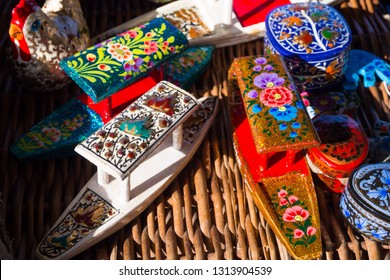Kashmir, often celebrated for its natural beauty, is equally renowned for its rich artistic traditions. The region’s handicrafts, shaped by centuries of craftsmanship, represent both cultural heritage and economic livelihood. While traditional techniques remain deeply embedded in these crafts, modern influences have gradually reshaped the industry. Today, Kashmiri artisans are navigating the delicate balance between preserving time-honored skills and adapting to contemporary market demands. This fusion has enabled Kashmir’s handicraft industry to remain relevant while retaining its unique artistic identity.
The history of Kashmiri handicrafts dates back several centuries, influenced by Persian and Central Asian craftsmanship. The introduction of these artistic traditions, particularly during the rule of Sultan Zain-ul-Abidin in the 15th century, played a crucial role in refining the skills of local artisans. Later, the Mughal emperors patronized Kashmiri crafts, further enhancing their intricacy and prestige. Some of the most celebrated handicrafts from Kashmir include Pashmina shawls, hand-knotted carpets, papier-mâché artifacts, walnut wood carvings and Kashmiri embroidery. Each of these crafts is a result of meticulous skill and labor. Pashmina shawls, for instance, are woven from the fine wool of the Changthangi goat, requiring delicate hand-spinning and weaving techniques. Similarly, Kashmiri carpets, known for their elaborate patterns, can take months or even years to complete due to their detailed hand-knotting process. Beyond their aesthetic appeal, these crafts embody Kashmir’s cultural identity. Every design, motif and technique tells a story, passed down through generations, preserving the traditions and history of the region.
Despite their cultural and artistic significance, Kashmiri handicrafts face several obstacles. One of the primary concerns is the declining number of skilled artisans. Younger generations often choose alternative career paths due to financial instability and limited opportunities in the craft sector. The influx of machine-made imitations further threatens traditional craftsmanship, as mass-produced replicas are sold at lower prices, affecting the livelihoods of authentic artisans. Additionally, political instability and economic hardships have disrupted the industry. Frequent market shutdowns, lack of infrastructure, and difficulties in reaching wider audiences have made it challenging for artisans to sustain their businesses. Many skilled craftsmen have shifted to other occupations due to uncertain earnings and lack of recognition.
Despite these challenges, Kashmir’s handicraft industry is evolving by embracing modern tools and strategies. Digital platforms have opened new doors for artisans, allowing them to sell their creations online and reach a global customer base. E-commerce marketplaces, social media and dedicated handicraft websites have provided a platform for direct trade, reducing dependency on intermediaries. Moreover, the adaptation of traditional designs to modern preferences has helped attract younger consumers. While classic patterns remain valuable, many artisans now experiment with contemporary color palettes, minimalistic designs, and customized products. Collaborations between designers and craftspeople have further introduced innovative variations of traditional art, ensuring its relevance in today’s markets. The demand for sustainable and ethical products has also benefited Kashmiri crafts. As more consumers seek handmade, eco-friendly alternatives, authentic Pashmina shawls, natural-dye textiles and handcrafted home decor items have gained popularity. This shift toward conscious consumerism has encouraged artisans to maintain quality while adopting environmentally responsible practices.
Recognizing the economic potential and cultural significance of handicrafts, the Indian government and various organizations have introduced measures to support artisans. Initiatives such as the Pashmina Wool Development Scheme, Handloom Cluster Development Program, and Geographical Indication tags for Kashmiri crafts have been instrumental in preserving and promoting traditional skills. Additionally, skill development workshops, financial aid programs, and marketing assistance have helped artisans sustain their craft. By providing training in modern business practices and digital marketing, these initiatives aim to empower artisans with the tools necessary to compete in today’s economy.For Kashiri handicrafts to thrive in the future, a balanced approach between preservation and innovation is necessary. While artisans should continue to uphold traditional craftsmanship, they must also adapt to evolving market demands. Training in e-commerce, branding, and digital marketing can enhance visibility and create new economic opportunities.
Furthermore, integrating handicraft education into vocational training programs can encourage younger generations to pursue careers in traditional arts. By offering sustainable wages and career growth opportunities, more youth may be inspired to carry forward their ancestral skills. Consumers also play a vital role in sustaining these crafts. By choosing authentic, handmade products over factory-made imitations, buyers contribute to the preservation of Kashmir’s artistic legacy.
Kashmir’s handicraft industry stands at the crossroads of tradition and modernity. While artisans strive to keep their centuries-old techniques alive, the evolving marketplace demands adaptation and innovation. Despite challenges such as declining artisan numbers and market disruptions, the industry has shown resilience through digital expansion, design evolution and ethical consumerism. With the right support from governments, organizations and consumers, Kashmir’s handicrafts can continue to flourish not just as cultural treasures but also as sustainable sources of livelihood. By bridging the gap between tradition and modern demands, these crafts will remain a timeless testament to the region’s rich heritage and artistic excellence.


